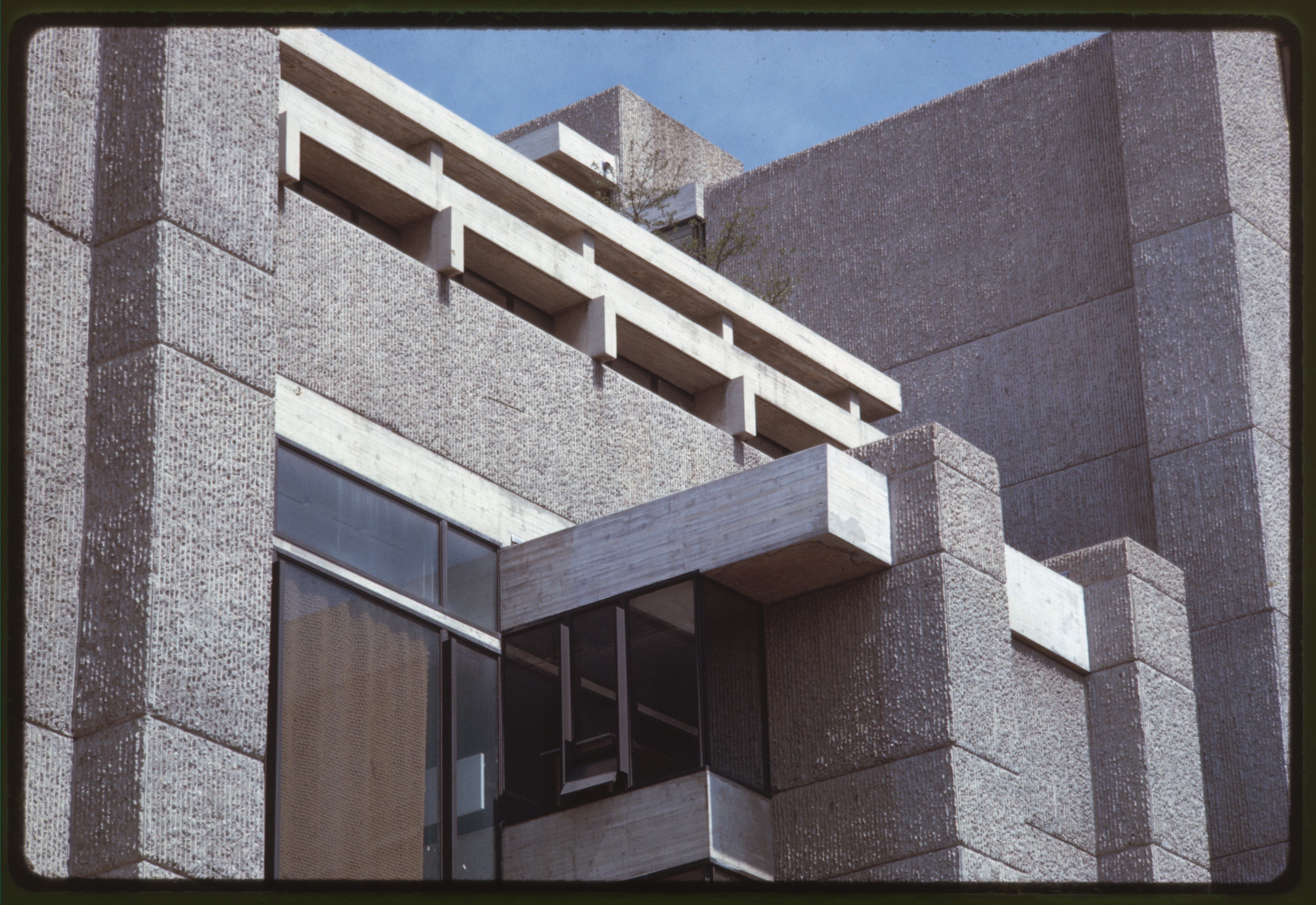
Art & Architecture building, designed by Paul Rudolph, built 1961 – 1963, Yale University. Library of Congress
By Christopher Wigren
(c) Connecticut Explored Winter 2017-2018
Subscribe/Buy the Issue!
What sane architect would willingly label his or her buildings as cruel, savage—in short, brutal? That’s the question that’s immediately raised by Brutalist buildings of the 1960s and 1970s.
The answer, of course, is: no one. Brutalism doesn’t take its name from the English word brutal, but rather from the French word brut, which means, among other definitions, raw or unrefined.
Brutalism emerged in the 1950s in reaction to International Style modernism, whose simple, boxy forms and steel-and-glass facades had come to seem blandly anonymous and suggestive of faceless corporate bureaucracies. Instead of uniformity and machine-like finishes, the Brutalists aimed for individuality and monumentality devoid of refinement as the word brutimplied. They wanted building exteriors to express the layout and functions of their interiors, and they wanted to rely on the true nature of materials to determine form.
Brutalist architecture is epitomized in one of the movement’s best-known examples, the Yale Art and Architecture building, completed in 1963. Architect Paul Rudolph assembled studios, offices, places for display and criticism, and a library in a complex composition of 30-odd levels (counts vary) made visible in the irregular forms of the exterior. For the walls, Rudolph specified concrete cast with protruding ribs that were hammered off, leaving rough stumps that expose the multicolored aggregate within. From a distance this produces a texture like corduroy: striated, irregular, almost fuzzy. Rudolph’s devotion to spatial gymnastics, however, in many ways overwhelmed his planning. Artists, for instance, griped about cramped, poorly lit studios and complained of skin abrasions caused by brushing against the rugged concrete.
Brutalism flourished through the 1960s and well into the 1970s before falling into disfavor. But not just disfavor. For years, the vitriol addressed at Brutalism reached a height known by few other out-of-favor styles. Buildings were described as eyesores, forbidding, impenetrable, egotistical, surly, grim.
One reason for the vitriol may be the Brutalists’ frequent use of concrete. While inexpensive and almost limitlessly flexible, concrete can feel dank and cold. It chips and stains easily, becoming unsightly. And it is more associated with garages or highway overpasses than with schools or churches.
Another problem is that Brutalism’s rise coincided with urban renewal. The heavy forms and rough textures of renewal-era housing projects or schools have fueled the legend that they were designed as fortresses to protect users against hostile and dangerous cities. But that belief doesn’t explain the fact that nearly identical designs also appeared in the most bucolic suburbs.
Perhaps the most serious problem lay in Brutalism’s aim, as expressed by promoters such as the critic Reyner Banham, to be powerful and straightforward rather than elegant. Balancing its monumental forms and rugged textures with human scale required great skill—more than many architects possessed. As the distinguished English architectural historian Nikolaus Pevsner observed at the dedication of Yale’s Art & Architecture building, even a mediocre architect could imitate International Style buildings and create something that at least was serviceable. Not so, he argued, with Brutalism. And when Brutalism is bad, it’s very bad—heavy and threatening, or grimly bland. These failures gave the whole movement a negative reputation that was only reinforced by the unfortunate name.
Recently, however, Brutalism has begun to enjoy a revival. In Boston, it’s been championed by architects Mark Pasnik, Michael Kubo, and Chris Grimley, who propose rebranding the style as a tactic for improving its standing. In a 2015 interview on The Atlantic’sCitylab website, Pasnik said, “I think ‘Heroic’ is a better title for what [Brutalist architects’] actual aspirations were.… They were developing architecture for the civic realm. They believed in democracy and had high aspirations.”
Recent renovation projects have provided opportunities to reconsider Brutalist buildings. In 2008 Yale completed a restoration of the Art and Architecture building that was led by Gwathmey Siegel & Associates. The spatial complexity of Rudolph’s interiors was restored, and a new (albeit visually underwhelming) addition improves the building’s functionality.Connecticut College took a less reverential approach with its Shain Library (1974, Kilham, Beder & Chu Architects). In a 2015 renovation Schwartz/Silver Architects preserved the original striated concrete and syncopated fenestration but made the building more approachable by enlarging some of the original slit windows and cutting open the façade for a glassy reading room. Back in New Haven, the city’s housing authority sponsored a National Register nomination for Crawford Manor, a 1965 high-rise also designed by Rudolph, and now is renovating the building.
Brutalism is hardly the first architectural style to be hated. The history of the preservation movement contains references to “inferior” Greek Revival design, tirades against Victorian buildings, and anti-Modernist screeds. For Brutalism, the hatred may have come on more quickly and been more persistent. But, like those styles, it too seems to be coming into its own again. And, luckily, many of its most important works are still around to enjoy new appreciation. One reason may be that they’re just too hard to tear down…
Christopher Wigren is deputy director of the Connecticut Trust for Historic Preservation, based in Hamden. His book, Connecticut Architecture: Stories in 100 Places (Wesleyan University Press) is expected Fall 2018.
